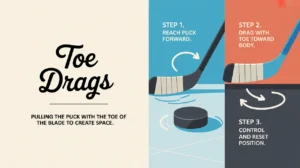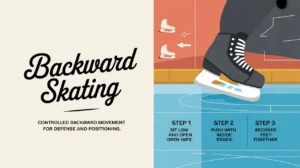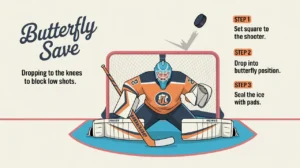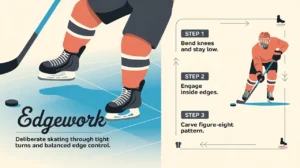Jim’s Intro to One-Timer
Hi folks, Jim here, the only commentator who, when asked for a perspective on “one-timers,” responded, “Well, everyone’s star fades eventually. It’s the circle of life.”
What is a one-timer?
A one-timer is a shot taken directly off a teammate’s pass without stopping or settling the puck first. It’s designed to catch goalies out of position and defenders off balance, turning a clean pass into an instant scoring chance.
How does it work?
The one-timer relies on timing, positioning, and precision:
- Stance: Stay balanced with knees bent and weight distributed evenly.
- Stick Position: Keep the blade open and ready in the puck’s path.
- Timing: Swing through the puck as it arrives, meeting it cleanly.
- Weight Transfer: Shift power through your legs and core for a strong strike.
- Blade Control: Adjust the angle depending on the speed and direction of the pass.
- Follow Through: Drive through the puck and finish toward the target.
- Communication: A good one-timer depends on the passer and shooter being in sync.
How do you make good decisions with it?
- Pick the Right Pass: The pass should be crisp and well-timed. Forcing a bad one-timer leads to turnovers.
- Know Your Lane: One-timers work best when the goalie is moving laterally.
- Adjust to the Pass: Don’t overcommit early; read the puck’s speed and angle.
- Use It for Quick Strikes: Ideal on power plays or cross-ice feeds.
- Don’t Force It: If the puck isn’t in a good position, it’s better to receive and shoot.
How do you master it?
Mastering the one-timer takes precise timing drills and repetition. Players work with partners or coaches feeding passes from different angles and speeds, focusing on clean contact rather than sheer power at first. Gradually, speed and complexity increase.
What does it look like when done right?
A great one-timer looks explosive and fluid, with the puck rocketing off the blade the moment it arrives, often before the goalie can set. The crowd hears the crack and then sees the red light.
Commentator’s Corner
Jim’s Take
A perfect one-timer is like a punch you don’t see coming. By the time the goalie moves, it’s already too late.
Parent Tip
Encourage players to focus on timing and blade control first. Power comes naturally once the mechanics are right.
Player Tip
Keep your stick quiet, your stance solid, and your eyes locked on the puck. Good timing beats wild swings every time.
A Final Thought
The one-timer is pure hockey drama. Master it, and you’ll turn great passes into highlight-reel goals before defenders know what hit them.









